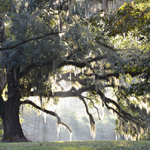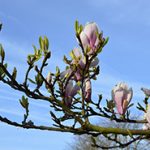Pages
Timeline Of Events : French Spanish Irish : Cajun Creole Africans : Native Tribes : Americans : New Orleans : Mardi Gras : Music : Streetcars : Slavery Antebellum Emancipation : Crime : Carlos Marcello : Mafia : Huey P Long : Jean Lafitte : Marie Laveau : Stanley 'Tookie' Williams : Louis Armstrong : Jim Bowie : Jerry Lee Lewis : Lee Harvey Oswald : Huey P Newton : KKK Jim Crow : Politics Religion : Arts Architecture Movies : The Mississippi : Ecology Weather : The Land : Flora and Forna : Mammals Birds Reptiles Aquatic Bugs
Flora and Forna
 To the north there are pine forests and prairies while in the south there are coastal dunes and marshes. Add in some dry sandy areas, lakes, rivers and swamps and you could not wish for a more diverse habitat.
To the north there are pine forests and prairies while in the south there are coastal dunes and marshes. Add in some dry sandy areas, lakes, rivers and swamps and you could not wish for a more diverse habitat.
The lakes and swamps with scruffy bald cypress trees are as characteristic of Louisiana as the live oaks dripping with Spanish moss.
The disparate array of trees includes mulberry, cherry, magnolia, hawthorn, ash, elder, maple, hickory, dogwood, dwarf palmetto, tupello gum, pecan and persimmon. The live oak and bald cypress which support the misnamed Spanish moss are not harmed by it. The plant is not a parasite and feeds on nutrients in the air and rainwater. However, it is often removed as it will reduce a trees resistance to strong hurricanes.
The coastal wetlands are continually under threat of erosion. Many native plants such as:
Big Bluestem, Yellow Wild Indigo, Ashy Sunflower, Gulf Muhly Switchgrass, Slender Rosinweed, Indiangrass, Eastern Gamagrass, Rough Coneflower, Seaoats, Illinois Bundleflower, Black Needlerush, Little Bluestem, Narrowleaf Mountainmint,and Rough Coneflower, are being encouraged to survive by various management and conservation organizations.
You should find swamp mallow, pickerelwood weed and the insect-eating pitcher plant, which entices unsuspecting bugs into its conical flower, where they slide down into the center, from which there is no escape as the plant slowly digests them.
The multifaceted prickly pear cactus offers food and shelter to many birds and reptiles. Containing fiber and pectin it has medicinal properties,  reducing blood glucose it helps diabetes sufferers and can assist in the healing of wounds and stabilizing urinary and digestive problems, even curing hangovers.
reducing blood glucose it helps diabetes sufferers and can assist in the healing of wounds and stabilizing urinary and digestive problems, even curing hangovers.
The plant is also used for making candies, jellies and alcoholic beverages.
In many areas the cactus is farmed for its use in Mexican cooking and the cochineal bug, living on the plant, provides the source for a commercially extracted red dye.
If that were not enough, the fruit is delicious.
The dwarf or bush palmetto also has its uses, the native Houma tribe have harvested the wild plant and earned an enviable reputation over the centuries for their hand-made baskets.
But for sheer beauty, nothing compares with the state flower, the magnolia.
